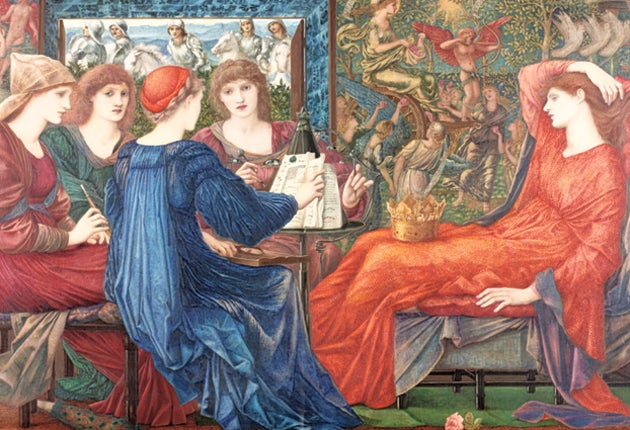The Cult of Beauty: the Aesthetic Movement 1860-1900, V&A Museum, London

Your support helps us to tell the story
From reproductive rights to climate change to Big Tech, The Independent is on the ground when the story is developing. Whether it's investigating the financials of Elon Musk's pro-Trump PAC or producing our latest documentary, 'The A Word', which shines a light on the American women fighting for reproductive rights, we know how important it is to parse out the facts from the messaging.
At such a critical moment in US history, we need reporters on the ground. Your donation allows us to keep sending journalists to speak to both sides of the story.
The Independent is trusted by Americans across the entire political spectrum. And unlike many other quality news outlets, we choose not to lock Americans out of our reporting and analysis with paywalls. We believe quality journalism should be available to everyone, paid for by those who can afford it.
Your support makes all the difference.What should make the curve of a brow, or the cherry flush of a lip, beautiful? Why are peacocks' feathers, rich in delicate texture and iridescent colour so unlikely, so pointlessly extravagant? What can we learn from contemplating such things? The Cult of Beauty at the V&A explores "the Aesthetic Movement" in Britain, an umbrella term for groups of individuals working across the various artforms at the end part of the 19th century, who believed in beauty for its own sake. As an exhibition it manages a critical recouping of rather unfashionable Victorian art, and also makes an intellectual, historical case for corralling together such figures as Dante Gabriel Rossetti, James McNeill Whistler, Oscar Wilde, Aubrey Beardsley and William Morris.
The exhibition gets off to a rather languid start, infused with melancholy, and this is probably so that we will have some clue as to how this all ends. Our opener is a replica of bronze statue The Sluggard (1885) by Frederic Leighton, a male nude study of an athlete. Rather than the triumphalism usually associated with such a subject, the athlete throws his arms back as though in weary rapture, as though he were succumbing to the sensation of tiredness, laurel wreath at his ankles.
Leighton's Pavonia (1858) is an utterly beguiling painting of a sultry dark-haired woman looking over her shoulder, as peacock feathers fan about her hair. Leighton's painted faces, which appear several times throughout this exhibition, are always rendered in a way that is both beautifully soft and peach-like, while being cold and smooth as silk. Indeed, through this exhibition's paintings it's women – rows and rows of women – who dominate as subjects. Not that they're domineering: all kissed mouths, faces wan with mourning, hands delicately dropping flowers, bodies supine. Some, like Rossetti's are pictured in heavily symbolic scenes, while in Albert Moore's Reading Aloud (1883-4), some women, pictured in a sea of patterned fabrics, drapes, cushions and dresses, simply another part of a calming decorative landscape. Whistler's paintings hum and flutter with painterly energy, recalling the work of the Impressionist painters working simultaneously in France. His Arrangement in Grey and Black, No 2: Portrait of Thomas Carlyle (1887-3) is a throbbing, grey painting of a seated man in black, with his dark coat draped over his knee: the man is just a shape in space – colour and form. His paintings of women in white however, shimmer with a lightness of composition, tone and atmosphere.
At times, the ambition of breadth here crosses over into crushed and confusing. it's a rather crowded installation, and so the construction of various rooms for peering into and seeing furniture seems gimmicky, as do brightly coloured projections of some of the key motifs. While it's difficult to display poetry and books in a space, the sound of recorded poems being read occasionally disturbed the atmosphere.
An aesthetic sensibility can bestow the tantalising taste of moral and intellectual freedoms, it also develops a desire to own and possess. However, it's undeniable that spending time with such luxuriant imagery is a kind of sensual and intellectual freedom itself.
To 17 July (020 7907 7073)
Join our commenting forum
Join thought-provoking conversations, follow other Independent readers and see their replies
Comments